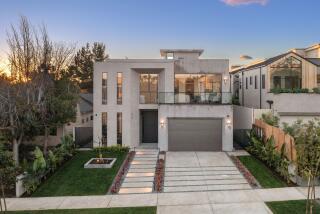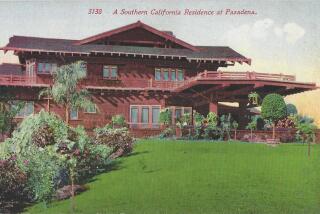HOME DECOR : Picture the Possibilities of Bay Windows, Experts Advise : On the outside, they add dimension and architectural interest to a home; on the inside, they act to extend the living area outward.
- Share via
Thanks to paradise-perfect days, Californians just can’t get enough of a view. For some, the ideal home is a cantilevered A-frame with a view of the Pacific. For others, it’s a sprawling ranch model, where walls of glass look out on sun-dappled patios surrounded by flower-filled gardens.
Whether your dream home is a chateau or a condo, chances are it features fascinating windows. But the trend is more mellow than modern, as Californians rediscover the charm of the old-fashioned bay window.
“A window is just a window,” says psychotherapist Rhea Vogt. “Even a whole bank of windows or sliding glass doors--which give us the feeling of free-flowing space--are still only two-dimensional.
“What’s so special about bay windows is their three-dimensionality, which creates the illusion of the indoors and outdoors coming together.
“The prime virtue of a bay window is that it’s like a little extra room, a room that’s all yours. We’re such a frenzied, harassed society. We have less and less personal space because of overcrowding. Bay windows are intimate, special places where people feel secure. It’s your little space--that’s something that you can’t get from a two-dimensional sliding glass door, which gives us a view, but not the intimacy and warmth we crave.”
Besides their emotional appeal, bay windows are practical--and aesthetically captivating. From the outside, bay windows add dimension and architectural interest to a home. On the inside, bays act to extend the living area outward, increasing the spatial dimensions of the interior and broadening the view.
Bay windows come in a wide variety of styles and sizes. The largest--and perhaps the most elegant--is the walk-in bay, with inviting floor-to-ceiling open space contained between the angles of the windows.
A pair of oversized, walk-in bays crowned with a circle-head window enhance one of the turrets in a large custom home in Fullerton. On the other side of the Tudor-style house is another turret, inset with a bay window at ground level and a balcony above.
The bay window in the living room embraces a space large enough for a pair of wing-backed chairs with a reading table and lamp placed between them. The other downstairs bay holds an efficient and attractive bar in the family room. The upstairs bay, which contains a writing area, frames a treetop view of the grounds.
Because the homeowners wanted to preserve lovely garden views, designer Lisa Weber kept draperies to a minimum: soft swags of fabric and cloud valances add a touch of color and tie the area in with each room’s decor.
For many homeowners, one of the most appealing features of a bay window is the many ways the space between the windows can be utilized. Traditionally, bay windows are associated with cozy, built-in seating areas where you can enjoy the wonders of nature while surrounded by the comfort of your home. Many bays are still used that way, with downy cushions covering window seats that conceal a handy, hidden area for storage.
When space is at a premium, bay windows are the perfect spots for built-in bookcases, cabinets, desks and countertops. One of Lisa Weber’s clients, who enjoys seasonal decorating, had a countertop built into a bay window that faced the sidewalk in front of her home. “Her gift to the neighborhood is the charming holiday displays she sets up for passers-by,” Weber says.
In some cases, it’s not exactly the view but the illusion of a view that makes a bay window intriguing.
Perhaps one of the most ingenious ways to use a bay window is to put it “inside” the home. When an architect placed a bay window--instead of a wall--at one end of a long narrow kitchen, a family gained a charming breakfast nook with a pretty view of the entry beyond.
Designer Linda Barth designed a booth, made up of a table and a curving built-in window seat, to fit snugly inside the bay and custom-designed leaded glass panes that repeat patterns used in adjoining areas of the home. “There’s so many things you can do with bay windows,” says Barth, “the possibilities seem endless.”
Because they are so adaptable, every room of the house is a candidate for a bay window. When used in a small bedroom, they “open up” the area because of the additional space and light they bring to the room. And, unless plumbing interferes, kitchens and bathrooms can be updated dramatically by adding bay windows.
Designer Naomi Mason used a bay window to surround a spa tub. To ensure privacy, Mason covered the window with a balloon shade, a luxurious window treatment that adds to the ambience of the setting.
“There’s something appealing about bay windows,” Mason says, “they’re cozy and romantic.” To create an aura of romance in a master bedroom, Mason suggests embellishing the window with lace curtains and placing a sofa or a chaise within the curve of the bay.
By incorporating the latest types of energy-saving features into the windows themselves, problems such as heat loss and fading can be overcome. Specially treated glass is available, as well as double-paned windows, which contain air space that conserves heat and muffles sound.


